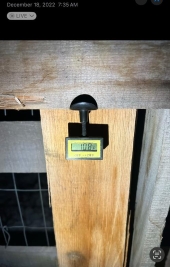Have you research anywhere?
From;
https://www.horsenation.com/2018/01/23/4-low-tech-ways-to-fight-frozen-water-troughs/
The Floating Object
Just as a river rarely freezes compared to a lake, moving water stays liquid longer.
How can we use that to our advantage without leaving a hose running all night long?
The answer is as simple as placing some large floating objects in our stock tanks.
A basketball, tennis ball, or other non-sinking object bobs and floats around in the water, agitating the surface and making it difficult for an ice skin to form over the top of the tank.
Plus there’s an added benefit in really cold weather! If an ice skin does manage to form, the floating object creates a weak spot in the ice that your horse
can more easily break by pushing down on the ball to create a drinking hole."
The Insulated Side Walls
Insulating the sides of our water tanks can keep them warmer which delays or prevents freezing.
How does this work? Heat is lost from your horses’ water to the surrounding atmosphere primarily via the principle of conduction.
Heat energy is transferred from the warmer substance to an adjacent cooler one where they are touching.
In our case, the air is cooler than the water as temperatures drop outside – at night, for example.
The Floating Lid
This is the same principle as putting on a hat to keep from losing heat from the top of your head.
You can do this with your horse’s water by using a floating piece of foam the size and shape of your vessel to insulate the surface of the water
from direct contact with the air, which prevents heat loss much like a pool cover.
When the horse pushes his curious nose on the floating foam, it sinks a bit and water flows over the top for him to drink.
Some commercially available foam water covers even have a bowl shape in the top that water pools in for easy drinking.








